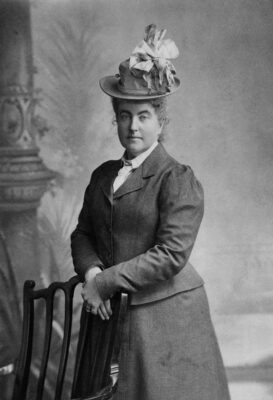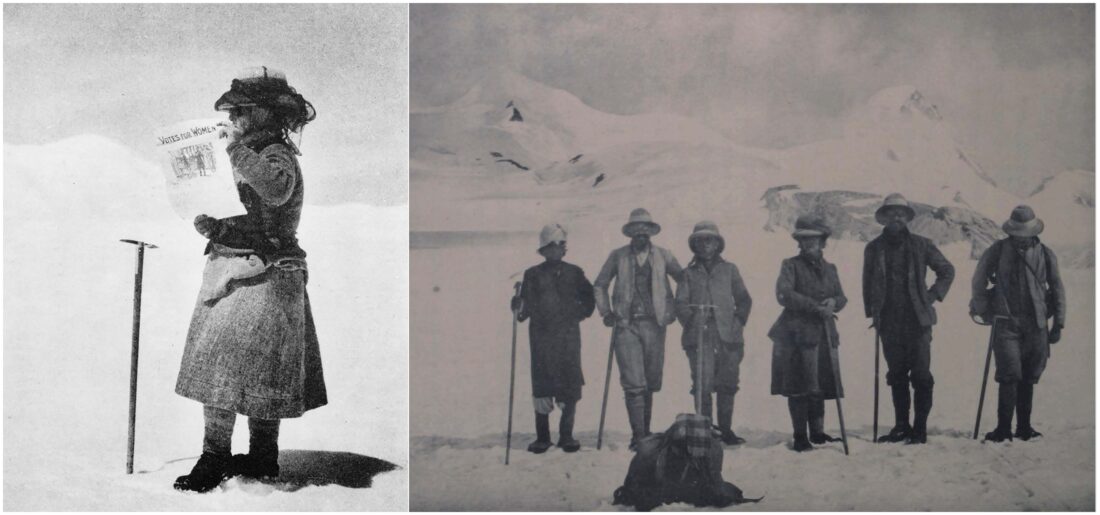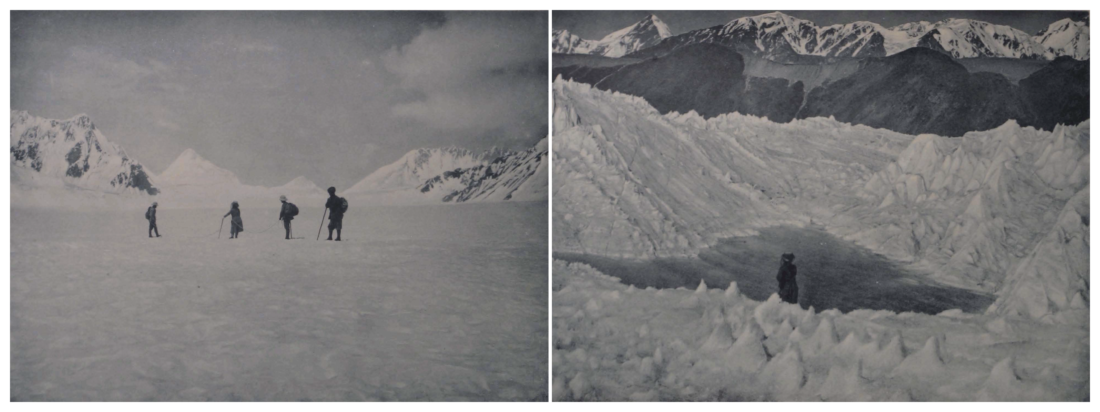
Fanny Bullock Workman carved a niche for herself by becoming the first woman to climb and explore the glaciers and high peaks of the Great Karakoram Range. At a time when mountain exploration was primarily the domain of men, her exploration of the Siachen Glacier, also called the ‘Rose Glacier’, in the Eastern Karakoram stands out as a remarkable feat to this day.
Born in 1859 into a wealthy, influential American family in Massachusetts, USA, Fanny was introduced to mountaineering by her husband, William Hunter Workman, who encouraged her to climb. Later, their move to Germany provided the ideal outlet for Fanny’s wanderlust as she climbed and cycled extensively in Europe, North America and Asia.
Fanny’s tryst with the mountain world of the Karakoram and the Himalayas began in earnest from 1898 to 1912. Along with William, she made eight trips in 14 years to Kashmir and the Karakoram, including the Nun-Kun massif. She covered almost the entire spectrum of the Karakoram Range, from the Depsang Plains and the Karakoram Pass in the east to the Hunza Valley in the northwest. Climbing the untrodden peaks of the Skoro La Glacier and the 21,000 ft Koser Gunge, Fanny was perhaps the first woman to see K2.
In 1902, she explored the Chogo Lungma Glacier, and climbed the Hoh Lumba Valley in 1903. She recorded the first ascent of the 6930 m high Pinnacle Peak in the Nun-Kun massif in 1906, which was the highest peak climbed by a woman at that time. In 1908, after exploring the 61 km long Hispar Glacier and crossing the Hispar Pass, Fanny explored the 60 km long Biafo Glacier in the northwest of Baltistan of the Great Karakoram Range.
A woman well ahead of her time, Fanny was pragmatic, strong-willed and outspoken. She was a champion of women’s rights and broke traditional societal norms to reach her chosen objective. Clad in her seemingly cumbersome mountain clothing of many layers, heavy boots, tweed trousers and skirts, woollen putties, and sun topie (hat), along with her long shaft ice axe, she was a moving landmark in her all-exploratory journeys.

L – Fanny and William Workman on the Bilafond La Pass
Adept in the technical skills of mountain climbing, with ascents of Matterhorn, Mont Blanc and Jungfrau under her belt, Fanny climbed with the mountain guides, matching their pace and proving women were as capable as men. She personified the modern woman’s vision of grit and determination and was a doughty woman explorer in the true sense.
Together with her husband, William Hunter Workman, who gave her his unflinching support, Fanny set the bar rolling for the generations of women to follow. The multi-talented Workman couple was the first husband-wife team to explore the Great Karakoram Range, and perhaps the first couple to explore any mountain range in the world.
In 1911, Fanny returned to Baltistan after an interesting journey from Kashmir. It included crossing many rivers and streams in zaks (improvised raft) and surviving the swas (mudslide) on several occasions. She carried out an expedition in the Karakoram, where they explored the Karmading and the upper Korkundus Valleys, the Sherpi Gang, Peak and Dong Dong Glaciers, and the lower Kaberi Glacier. Leaving the Saltoro Valley, they moved up to the Hushe Valley and explored the Masherbrum, Khondokoro, Aling, and the Chogolisa Glaciers. After the Sherpi Gang region and the glaciers of the south face of Masherbrum, Fanny and William decided to head to Goma in the Saltoro Valley for more mountain work. This marked the beginning of their rendezvous with the Siachen Glacier.
1911 Exploration of The Siachen Glacier
The team left Goma on 14th August. After traversing the Bilafond Glacier, they crossed the Bilafond La (Pass) at 18370 ft and the Lolofond Glacier to reach the Siachen Glacier. They explored its basin and its two affluents, namely the Tarim Shehr and the Peak 36 Glaciers, before retreating to the Goma Valley in late September 1911. During their short stay, they also climbed a peak of 21000 ft. As Fanny stood on the top of Bilafond La towards the end of the journey in 1911, she knew she would be returning to the Siachen Glacier.
1912 Exploration of The Siachen Glacier
“Whatever the hardships, whatever the difficulties, let me O Allah, return thither again.” Her prayers were answered and Fanny Bullock Workman, age 54 yrs, along with her husband William, age 66 yrs, returned to the Siachen Glacier. The ’Fanny Bullock Workman Expedition 1912’ was a ‘private expedition’ of which she was the Team Leader. Her main aim was to explore its high sources, map the glacier, and fill in the existing voids in spite of the glacier having been reached earlier.
The 46-mile Siachen Glacier, the longest non-polar glacier in the world had attracted many travellers and explorers since 1821. Notably, Colonel Henry Starchy in 1848, was the first to see it and ascend its tongue for over two miles. In 1889, Colonel Francis Younghusband reached the foot of the east source pass (Turkestan La), approaching it from the north, from the Urdok Glacier. Almost two decades later, the notable British explorer and climber, Dr. Tom Longstaff was the first to reach the Siachen basin after crossing the Bilafond La and the Lolofond Glacier. Yet the full extent of this glacier, its periphery, sources, extent, and cross-linkages with other glaciers of the Karakoram were unknown and were still a mystery. Fanny and William Workman were now the next explorers to visit the Siachen Glacier.
The ’Fanny Bullock Workman Expedition 1912’ explored the Siachen Glacier. Nearly 850 square miles of glaciated, mountainous territory of the Eastern Karakoram was mapped, and 40 plus peaks were measured. The glacier was surveyed from east to west and from north to south. All the chief affluents of the Siachen Glacier were explored and mapped. The north, south, and east Siachen sources were discovered. Profiles of the north east ridge of the Gashebrum Peak and Gashebrum Glacier were photographed for the first time, and also new peaks were discovered in Chinese Turkestan. Peaks of the King George V Group were seen, identified, and mapped. Two first ascents of peaks above 21000 ft were made. Silver Throne Plateau was discovered and explored, and the Silver Throne Col was reached. Sia La, a new pass was discovered, and a first descent was made to the head of the 20 mile-long Kaberi Glacier.
Interestingly, throughout the expedition, Fanny was accompanied by three hardy crows, who were her constant companions from the start of the expedition at Ali Bransa. They were always at their energetic best and never showed any signs of glacial lassitude or mountain sickness. Fanny’s favourite companions on the glacier mysteriously disappeared after reaching the Kondus Valley.
The exploration of the Siachen Glacier over a century ago was an extraordinary expedition spread over two years. It was driven by the passion of a remarkable woman, who walked almost everywhere on the ‘Rose Glacier’. Fanny Bullock Workman thus became the First Woman to ‘set foot’ on the Siachen Glacier. Her bold, detailed exploration of the largest non-polar glacier in the world, helped put in place its final geographical connection and perspective with Central Asia and the Eastern Karakoram.
While the footprints of Fanny Bullock Workman may have disappeared with time, her indelible imprint on the Siachen Glacier will forever stand tall as one of the finest journeys of exploration, climbing, and human endeavour in the Karakoram.

R – Fanny Bullock Workman at a Glacial Lake on the Siachen Glacier
Photo Credit – Fanny Bullock Workman Expedition 1912

Brigadier Ashok Abbey
A passionate climber for over four decades, Brigadier Ashok Abbey has climbed extensively in the Karakoram, Great Himalayas, and adjoining mountain ranges. He has climbed, led, and participated in many International and Indian Mountaineering Expeditions to 5000, 6000, 7000, and 8000-meter mountains successfully. A subject expert of Mountaineering History and Himalayan Exploration, he is a master of Mountaineering, and Mountain Rescue matters.

An interesting read about a woman who was far ahead of her time and who showed remarkable character in taking the challenges head-on. Stories of such extraordinary people inspire people for generations.
Beautifully written account of Fanny Bullock Workman about the exploration of Siachen Glacier in specific and other mountains in general. Brig Ashok Abbey has highlighted the aspects which many of us may not be aware. Great work indeed.
A lovely read fascinating n interesting ashoks knowledge about mountains n Mountaineering is immense… enjoyed reading about a woman’s fascinating journey in the mountains..
What a lucid and brilliantly put forth account of Fanny Bullock Workman’s historic exploratory work in the high altitude glaciers and mountain peaks in the Karakoram Range the Siachen Glacier..Well researched and a good read.
Wow 🤩 what a woman 👍🏻🙌🏻😘🤩🤩
Amazing woman ! Awesome!